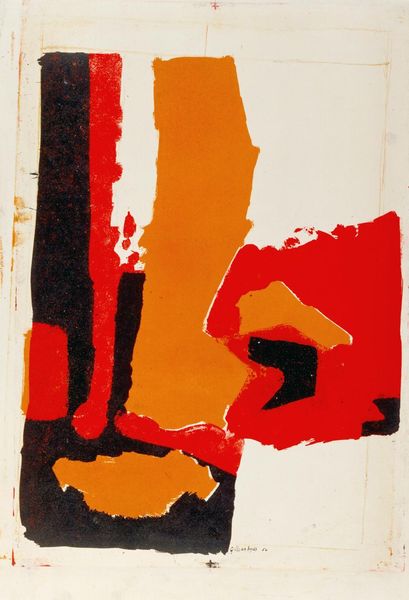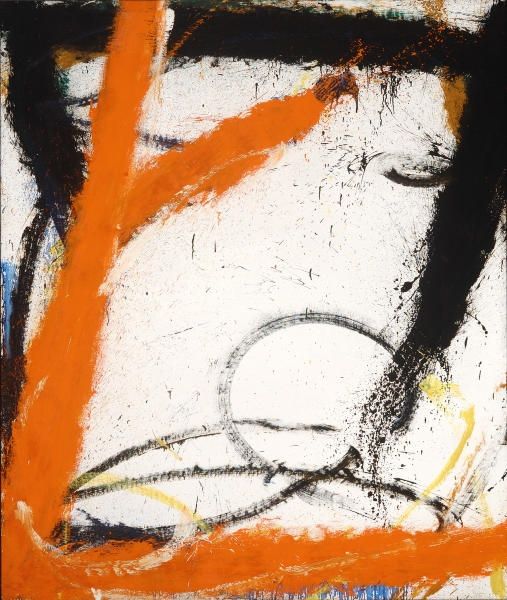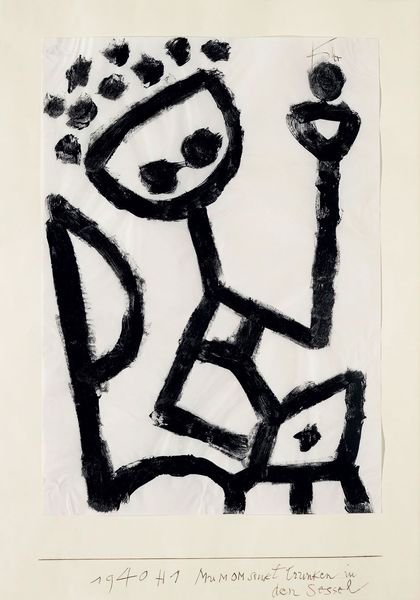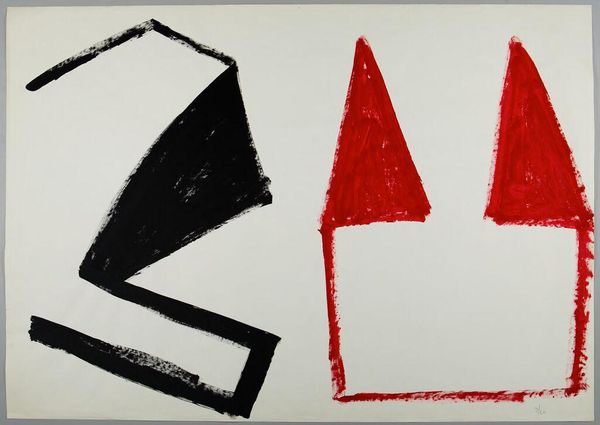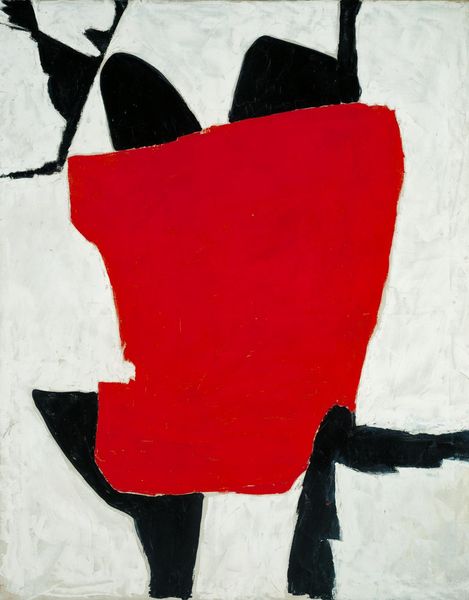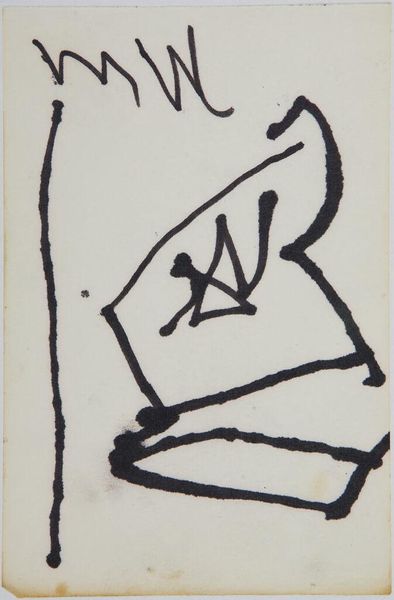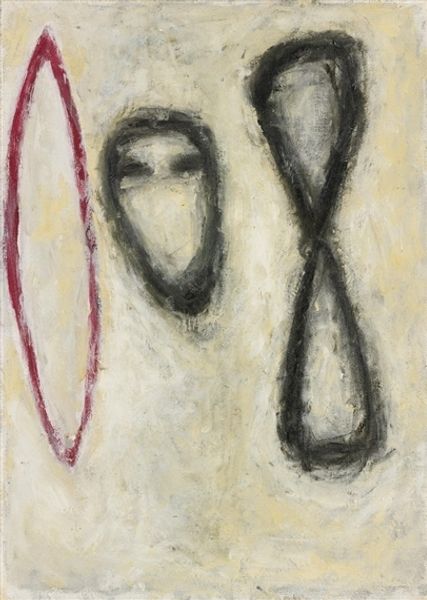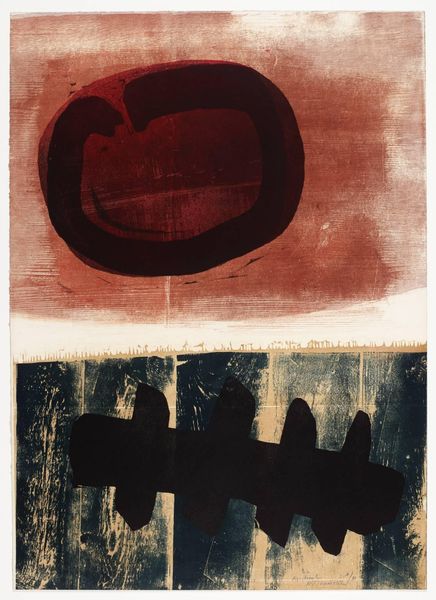
drawing, paper, ink
#
abstract-expressionism
#
drawing
#
paper
#
form
#
ink
#
geometric
#
abstraction
#
line
#
modernism
Copyright: Public Domain
Curator: Standing before us is Paul Klee's "alea jacta," created in 1940 using ink and paper. What strikes you immediately? Editor: An unsettling mix of playfulness and harshness. The stark geometric forms rendered in bold black and punctuated with that intense red create a rather striking, unsettling presence. Curator: Given the context of its creation, that tension seems appropriate. 1940 was a year of immense global turmoil. The title, "alea jacta," Latin for "the die is cast," suggests an acceptance of inevitable fate. Do these symbolic elements evoke specific connotations for you? Editor: The circle and line combination at the top could be seen as a gender symbol perhaps denoting Mars and virility. A bold black stroke through the middle suggests the inevitable disruption through chaos of a well-defined order of shapes, such as the ordered spots grouped nine-fold beneath it. The colour enhances that as it reminds us of the aggression of war. Curator: Klee had been grappling with illness for years, and the rise of Nazism deeply affected him. His work increasingly reflected these struggles, even though he continued to express that in his signature poetic visual language. It’s as if the geometric shapes symbolize both order and its inherent fragility when confronted with chaos. This feels very true of the sociopolitical upheavals. Editor: Absolutely, and the red, especially, it doesn’t just represent aggression; it embodies urgency and alarm. The symbols feel almost like ancient runes, whispering forgotten prophecies of imminent doom. Curator: Klee often incorporated symbolic languages in his work, drawing on various sources. But here, the language feels starker, almost urgent, mirroring the period’s anxieties. It encourages reflection on how these symbols recur throughout different social struggles and why they become more meaningful each time. Editor: The material adds a final nuance. Ink on paper renders everything fleeting as both will degrade across the coming decades. That impermanence of mark adds additional melancholy of inevitability of the artwork and humanity’s ultimate passing from any stage of dominance or aggression. Curator: Yes, "alea jacta" is an incredibly layered piece that invites us to engage with Klee’s world. Editor: An era captured in an unforgettable image that retains its immediacy, so many decades later.
Comments
stadelmuseum over 1 year ago
⋮
'The Die Is Cast' was created in March of the war year 1940, three years before Paul Klee died. As always, the artist linked his drawing with a poetic title. The Latin "alea iacta est" recalls not only Caesar's exclamation when he crossed the Rubicon, as recorded by Suetonius, but also the comment of the humanist Ulrich von Hutten - "I dared to do it." - as he looked back on his life, which ended in 1523 in exile on the island of Ufenau, in Lake Zurich. Klee had emigrated to Switzerland in 1933 after being dismissed by the National Socialists from his teaching post at the Düsseldorf Academy. He spent his last creative years, seriously ill, in his studio in Bern. Sensing his approaching death, the artist chose this expressive saying to match the content of his drawing, which reveals its fateful dimension with a seemingly intuitive and yet calculated formal language.Klee offers his vivid metaphors on a rather battered sheet of laid paper, which he mounted on cardboard. Especially in view of the fact that it was created around Easter time, 'alea jacta' reminds us of the display of the tools of Christ's martyrdom and the Veil of St Veronica in Good Friday processions in Switzerland. The viewer is offered a number of possible representational associations, such as a drumbeat seen from above - it could also be a still-swinging clock pendulum - a flag or a hatchet, a boat linking faraway shores and, finally, not the six eyes of a die but, strangely, nine orderly dots, a number that corresponds to the hierarchy of angelic choirs. The drawing gains its particular strength and validity through the tension created by the ambiguous and impressive black signs applied with broad brushstrokes, together with the amorphous blood-red patches of colour and the fragile-looking paper.Klee's ability to penetrate the different facets of his existence in an artistic way is one of the characteristic qualities of his work. Driven to the limit in form and content, this late drawing tells of the end of his search to find the way to himself. With its primordial-looking style of composition and symbolic pictorial language, it can be read as an expression of the creative elemental forces in man. Klee's interest in the pictures of children and artistic outsiders is well known, but unlike those of his Swiss contemporary Louis Soutter, for example, Klee's works are sustained by an unceasing and critical awareness of the creativity of the individual.
Join the conversation
Join millions of artists and users on Artera today and experience the ultimate creative platform.

